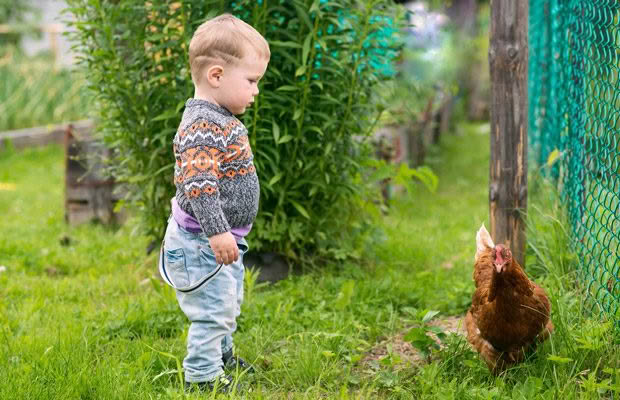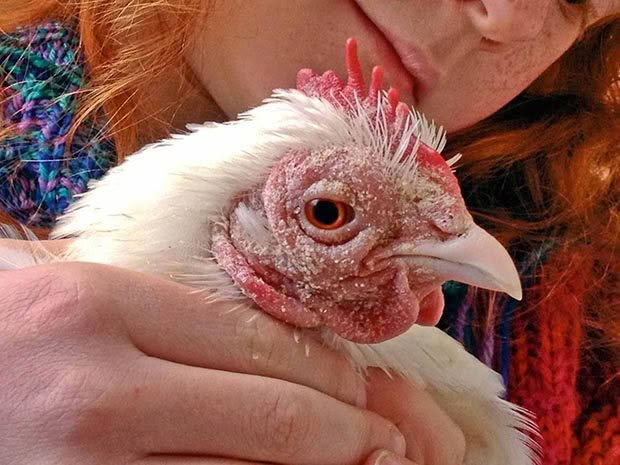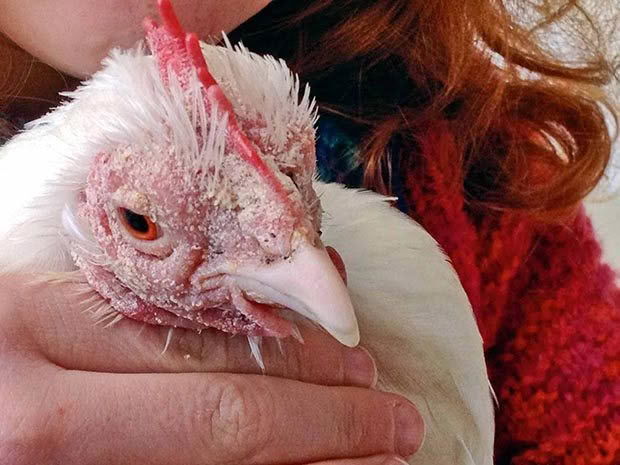How to make your hens like you

Some hens aren’t fussed on humans, while others think they rule the roost and don’t understand why they can’t live with you in the house. Research by a NZ-based animal behaviour expert is now available to show farmers how to make a hen’s life happier.
Words: Sue Clarke & Nadene Hall
Make a big noise, especially suddenly, or wave your arms about and most chickens will run off. A big enough shock can actually put some birds off laying , so knowing how to behave when you’re around poultry can have a big impact.
Dr Lauren Edwards works as a lecturer in Applied Animal Behaviour and Welfare at Unitec Institute of Technology in Auckland, but her PhD research – Human-animal Interactions in the Laying Hen – suggests that the human-animal relationship is very important for laying hens’ welfare and productivity.
It has long been established that poultry are innately fearful of humans, and that farm animals experiencing fear in the presence of stockpeople suffer from reduced welfare and productivity due to repeated exposure to this stressor. Lauren has researched human-animal relationships in commercial cage-layer facilities in Australia and in the USA, focusing on relationships between hen avoidance behaviour (as an indicator of fear of humans) and the behaviour and attitude of stockpersons on egg farms. It showed that by using non-threatening behaviour around the hens, stockpersons can help poultry overcome their innate fear of humans and improve their welfare.
Attitudes and behaviour are closely linked says Dr Edwards. “In general, negative stockperson attitudes were associated with more noise, faster speed of movement, less time spent stationary, and less time in the ends of the aisles.
“Positive attitudes and empathy were associated with less noise, although there were fewer significant relationships for these attitudes.”
Interestingly, the laying hens displayed greater avoidance behaviour in laying houses where the stockpeople made more noise, and less avoidance behaviour in laying houses where stockpeople spent more time standing still in front of the cages, evidence that the attitudes of stockpeople toward their work were associated with behaviours that directly influenced fear of humans in the birds.
“These attitude-behaviour relationships for stockpeople working in the egg industry suggest a sequential human-animal relationship, in which stockperson attitudes may influence the welfare of laying hens.”
Further experimental research results have consistently suggested that close proximity of visual human contact is effective in reducing the behavioural response of hens to human contact. Interestingly, the duration of human contact was found not to be a significant factor. By keeping the amount of noise that they make to a minimum, and by working closely to the birds in a calm and non-threatening manner, stockpeople can reduce the level of fear that their flock experiences. A calmer flock is more pleasant to work with, and it may be beneficial for productivity.
Source: The Poultry Hub, Poultry CRC, www.poultryhub.org
HOW STRESS CAN AFFECT EGG PRODUCTION & EGG QUALITY
Hens can be put off laying by several types of stressors which compromise reproductive functions. Some stressors like a fright, rough handling or an inability to get into their favourite nest can cause a temporary fault with the shell, ie body checks or fine but healed cracks in the shell. A bird that is frightened enough to withhold an egg from being laid may see it lay an egg with an extra dusting of calcium crystals, or it might be slab-sided or misshapen.
These effects can be replicated by injecting birds with adrenalin, so it is known that the production of adrenalin (the ‘fight or flight’ hormone) in a stressful situation can affect egg shell deposition. The effects of a stressful condition can also be measured by the higher heterophyl/lymphocyte ratio in the blood and plasma corticosterones.
The stress of hot weather (temperatures above 25°C) can result in the production of smaller eggs. This is because food intake is decreased and there is less nutrition available for egg formation. Feed should be more concentrated in this instance as birds are eating less. Extra fat in hot weather can be beneficial. Other ways to reduce heat stress are to feed birds during cooler times of the day and to provide cooler drinking water on hot days.
Other stressors that can reduce egg quality, and/or stop a hen from laying altogether can be diseases, a change in diet, or a lack of food or water for a period. A reduction in day length once past the shortest day also affects the pituitary gland which in turn affects the hormones, stimulating or retarding ovary development.’
Your questions, answered
Q: We were wondering if you might be able to assist us please, with a diagnosis and/or advice on how best to look after Creamy, our pet pekin bantam.
Age: 2 ½ years
Breed: Pekin Bantam
Sex: Female
Location: Nelson
Bird house: 4 year old purpose-built (of new timber), raised chicken house, partially insulated, ventilated, 5 externally attached nesting boxes.
Notes: She is one of 6 hens, with 1 rooster. We don’t use a deep-litter system as it’s difficult to obtain untreated wood shavings, so we use meadow hay. The house is cleaned, with the hay replaced, about every 6 − 8 weeks.

Symptoms: Whitish dry eczema-like condition on her face, ears, and wattles, which appears to have caused thickening of her skin around her eyes. She also has thickened legs from what we suspect is scaley leg mite. None of the others have the facial condition. The rooster has mites too, although not as severe. Our main concern is her face, as it has happened so rapidly, accompanied by an unusual smell. She flicks her head, scratches at her face, and opens and closes her beak occasionally.
Droppings: We haven’t noticed any unusual droppings, though can’t be sure.
Breathing: Her breathing seems normal.
Eating habits: She seems to be eating normally.
Changes in condition: We’ve been treating her legs with Vaseline®/oil mix intermittently for about a year, though not aggressively so, which is probably what it takes. Her face however, has probably been like this for about 6 − 8 weeks. We’ve tried putting oil on it a few times.
Behaviour: She seems a little quieter than previously, and sits with her hatchling sister (who is the lowest-ranked) prior to roosting.
Mobility: She gets around ok, but may be a little slower.
Worming regime: Wormed with ivermectin, no other medications. Our 8 year old daughter is very fond of the chooks and gets physically quite close to them, so I guess what we need to know is could it be transmittable to humans, and/or contagious to the rest of the flock?
Frances Wood, Nelson
NZ Lifestyle Block poultry expert Sue Clarke replies: I think your hen could be suffering from a condition called favus, also known as whitecomb. It is caused by a type of fungi and is sometimes described as though the face has been sprinkled with flour. It may clear up on its own but you can aid recovery by coating it with an antifungal cream – try one that is available for athlete’s foot in humans or a mange treatment available for dogs, but be careful when applying around the eye.

Favus can be passed onto humans and may be seen as a sort-of dandruff in the scalp. My main reference book also says the way to prevent it is to improve nutrition and breed for resistance. It can be passed to other birds, but if they are fit and unaffected they may be resistant, just like some people are to thrush which is a similar sort of infection.
The other possible cause is the same mite which causes scaly leg mite, Knemidocoptes mutans, which you mention they may have. The ivermectin treatment (at a dose of 0.1ml per kilogram, that’s a drop per 1kg of bird) may help as it deals to external and internal parasites, but you can also try treating the scaly leg again with Vaseline®. You don’t need to mix it with oil – one or other does the same job in suffocating the mites – and the thicker the coating, the better. Try and do it every 2-3 days so it doesn’t get rubbed off easily. Rawleighs ointment may be a good alternative if you have any. Mites around the eye are much harder to suffocate using Vaseline® alone so I would recommend both a dose of ivermectin and the Vaseline® treatment to give it a double dose.
Q: Can you please tell me how to get my chickens’ bums dry? I have 25 Brown Shaver/Hyline hens and seven of them have damp, dirty and smelly bums. All the rest are ok. I feed them all the same pellets (HR Fiskens layer pellets) and they have plenty of fresh clean water. Is there something that I can give them or something that I can put in their water to help them dry out?
Charlie, by email
Sue replies: It’s going to depend on what is making their bum feathers wet and smelly. Wet droppings can be caused by a number of conditions, but it’s usually due to a digestive upset – too many ‘bad’ bacteria in the gut – or a disease affecting the kidneys like Infectious Bronchitis which causes them to drink a lot.
Another possibility is too much salt or molasses in the feed as this will also make them drink more. Sometimes worms can cause a bit of scouring, but so can other parasites like coccidiosis. The first thing you could try is putting some cider vinegar or white vinegar in their water supply for one day every two weeks (repeat 2-3 times) and see if it helps (5ml to 10 litres of water). The vinegar acidifies the gut a bit more than normal and may help kill off any bacteria causing the scouring. Make sure you don’t over-treat or they won’t drink the water, and only treat for one day each time so ‘good’ bacteria can re-colonise the gut again.
If you haven’t wormed them then you can use either of these methods:
1. Aviverm is a commercial worming treatment you put in the water for 24 hours that you can buy from your vet (make sure it is for large birds). The treatment is 1ml per 9kg of birds – I assume the whole flock weighs probably 2.2kgs x 25 = 55kg so by my calculations, that’s 6ml and that’s what you’d put in their water for one day. Mix it in about 10 litres of water and perhaps add some cranberry juice to disguise the taste.
2. The alternative method is to get some Eprinex Cattle Pour On (pour on only) from a vet or ask a friendly farmer/neighbour as you only need a tiny amount even for 25 birds. Also get a tiny syringe that measures in 0.1ml increments (these cost 50c or so from your vet). The treatment is 0.1ml per kg, so for adult Shaver/Hylines that would be just two drops on the bare skin under the wing of each bird to treat it for both worms and mites for a couple of months.
I’d keep snipping the wet pooey feathers off the affected birds so they don’t make more of a mess when they toilet.
Love this story? Subscribe now!
 This article first appeared in NZ Lifestyle Block Magazine.
This article first appeared in NZ Lifestyle Block Magazine.
